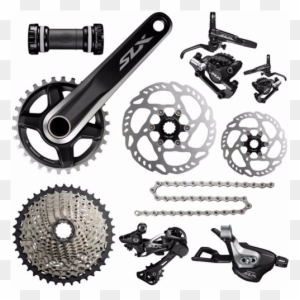According to Marketing 91.com, the top 10 bike brands in the world are

- Giant
- GT
- Santa Cruz
- Trek
- Specialized
- Cannondale
- Marin
- Yeti
- Kona
- Merida
I could run down the list and tell you where they’re made, how long they’ve been in business, what market they’re after and what makes one different than the other, but the reality is this: Each performs research and development, is a frame maker, and an assembler. For the most part, the collection of parts that make up the bike are made by somebody else. Someone else makes the wheels, the tires, the brakes, the shifters, the derailleurs, the chain and so on.
Within each brand, some bikes are better than others. I’ll start with the frame. Different materials, different levels of research and development, different manufacturing  processes, and warranty offered are some reasons why one frame costs more than another. Where the frames are made, the quantities made, labor costs, assembly efficiency (and in the high-end realm, hand building) are some other reasons that one frame costs more and is more sought after than others.
processes, and warranty offered are some reasons why one frame costs more than another. Where the frames are made, the quantities made, labor costs, assembly efficiency (and in the high-end realm, hand building) are some other reasons that one frame costs more and is more sought after than others.
That explains the price range for the frames. The price range for the parts varies as well. There are high end parts, low end parts, and lots of categories in between. In most cases, the manufacturer buys parts from a third party, however some produce various components for their own bikes.
When comparing parts (components) on bikes a term you might come across is “Groupset”, “Gruppo”, or “Group”. For the most part, a Group is a collection of mechanical or electronic parts involved in braking, changing gears and running of the drive train. The “big three” manufactures of groupsets are Shimano, SRAM and Campagnolo. Shimano and SRAM can be found on road, mountain and hybrid bikes and are most prevalent in the States. Campagnolo focuses on road bikes. Each of these manufacturers have a hierarchy within each of their lines for Road, Mountain and Hybrid. (I won’t get into the group names, however, looking at Shimano, they have 6 levels of road specific groups with the “Creme de la Creme” being Dura-Ace). Each group is incrementally better in some way. Some reasons for price and performance differences include weight, research and development costs, design, durability,  precision and materials used. For example, a lesser part may be made from steel and plastic, while a better part may use aluminum, carbon fiber and titanium. I’ve seen bikes equipped with a specific group, having one part (usually the rear derailleur) a step above. The bike maker is banking on the buyer associating that part with the overall quality of the bike.
precision and materials used. For example, a lesser part may be made from steel and plastic, while a better part may use aluminum, carbon fiber and titanium. I’ve seen bikes equipped with a specific group, having one part (usually the rear derailleur) a step above. The bike maker is banking on the buyer associating that part with the overall quality of the bike.
Besides the big three groupset guys, there are other specialty brands who focus on other parts of the bike. Some offer more budget-based or generic parts while others focus on super high-end parts. It’s not uncommon to see a new bike equipped with shifters and derailleurs from one company, brakes from another, saddle, wheels, suspension, seatpost and handlebars all from different manufacturers. Regarding the high-end parts, a bike company’s top of the line model is built for those who want the best, regardless the price. I don’t know for sure, but I’d bet that the high end parts companies make most of their money from those cyclists looking to upgrade the bikes that they already have. (wheels for example – considered by most to be the most effective upgrade) rather than selling to manufacturers.
Two final observations regarding brand – you may find the same frame on bikes of several price points. It’s all about the parts in these circumstances. Let’s consider the entry level hybrid. One price point may offer a bike with rim brakes, a 21 speed drive train and basic wheels. For $200 more, you get disc brakes, a 24 speed drive train and lighter wheels. For $150 more than that, get 27 speed, better disc brakes and even lighter wheels. Same frame, different parts. It’s mostly the parts cost which is the difference between a $300 hybrid, a $500 hybrid and a $650 hybrid. Buy what you can afford, but be advised that better parts make a better bike.
There’s also the difference of comparing different frames with the same parts. With parts being the same, you can do a fair comparison of bikes from different manufacturers. Similar bikes at similar price points across different brands usually have similar parts. At this point, other subtleties can affect your decision. For example, I like Shimano shifters better than SRAM shifters. Same price point and same quality – it’s just that they operate differently and I prefer Shimano.
And finally, there’s the difference of comparing bikes within the same brand. A carbon fiber frame generally costs more to produce than an aluminum frame and when the parts are the same, that price difference carries over. Yet another give or take choice for meeting your budget.

